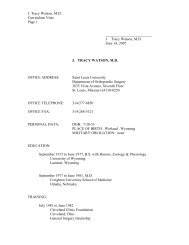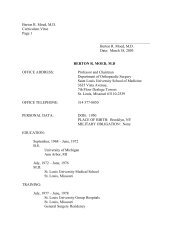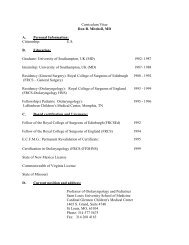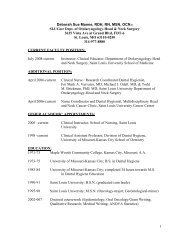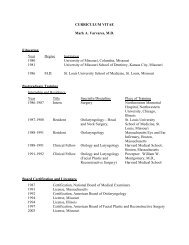Living Image 3.1
Living Image 3.1
Living Image 3.1
You also want an ePaper? Increase the reach of your titles
YUMPU automatically turns print PDFs into web optimized ePapers that Google loves.
C. Detection Sensitivity<br />
192<br />
At f/1, the depth of field ranges from ~0.2 cm at FOV= 3.9 cm (IVIS ® Imaging System<br />
200 Series only) to ~2 cm at FOV= 25 cm. You can use the manual focus option on the<br />
Control panel to easily assess the depth of field at any f/stop and FOV setting. For more<br />
details on manual focusing, see page 32. Generally f/1 is recommended for low light<br />
luminescent images and f/2 or f/4 is recommended for brighter luminescent or fluorescent<br />
images.<br />
<strong>Image</strong> Exposure Time The image exposure time also affects sensitivity. The number of photons collected is<br />
directly proportional to the image exposure time. For example, an image acquired over a<br />
two minute exposure contains twice as many detected photons as an image acquired over<br />
a one minute exposure. Longer exposure times are usually beneficial when imaging very<br />
dim samples. However, this may not always be true because some types of background,<br />
dark charge in particular, increase with exposure time. (For more details on backgrounds,<br />
see Appendix E, page 203.) An IVIS ® Imaging System has extremely low background<br />
that enables exposures of up to 30 minutes. However, animal anesthesia issues and<br />
luciferin kinetics limit practical exposure times for in vivo imaging to 5-10 minutes.<br />
Field of View (FOV) The FOV indirectly affects sensitivity. Changing the FOV without changing the binning<br />
or the f/stop does not significantly affect sensitivity. However, CCD pixels are effectively<br />
smaller at a smaller FOV (higher magnification) so that higher levels of binning can be<br />
applied without loss of spatial resolution.<br />
C.2 Binning<br />
Figure C.2 Lens f/stop positions.<br />
Left: lens wide open at f/1; right: lens closed down at f/8.<br />
For example, an image acquired at binning=4 and FOV=20 cm has the same spatial<br />
resolution as an image acquired at binning=8 and FOV=10 cm. Due to the increase in<br />
binning, the latter image has a four-fold increase in sensitivity compared to the former.<br />
A charge coupled device (CCD) is a photosensitive detector constructed in a twodimensional<br />
array of pixels. After an image is acquired, each pixel contains an electrical<br />
charge that is proportional to the amount of light that the pixel was exposed to. The<br />
software measures the electrical charge of each CCD pixel and assigns a numerical value<br />
(counts). (For more details on counts and other measurement units, see Appendix D,<br />
page 197.) The resulting image data comprise a two-dimensional array of numbers; each<br />
pixel contains the counts associated with the amount of light detected.




